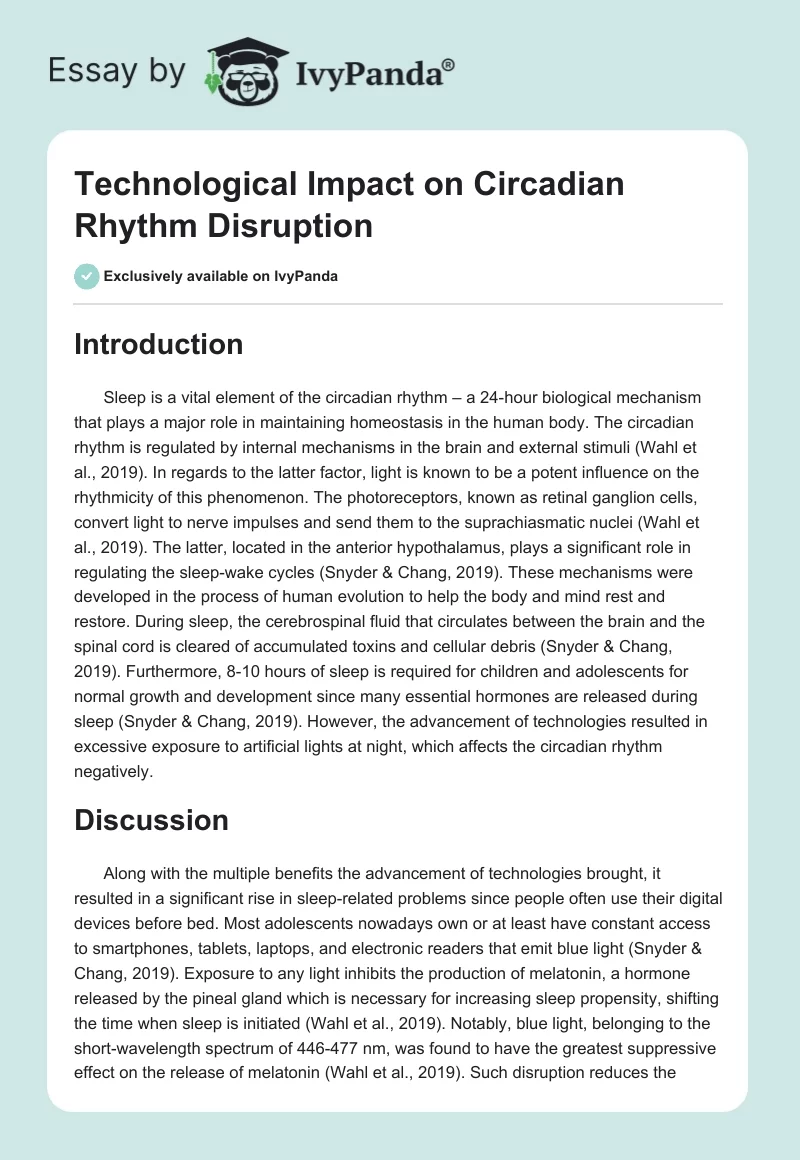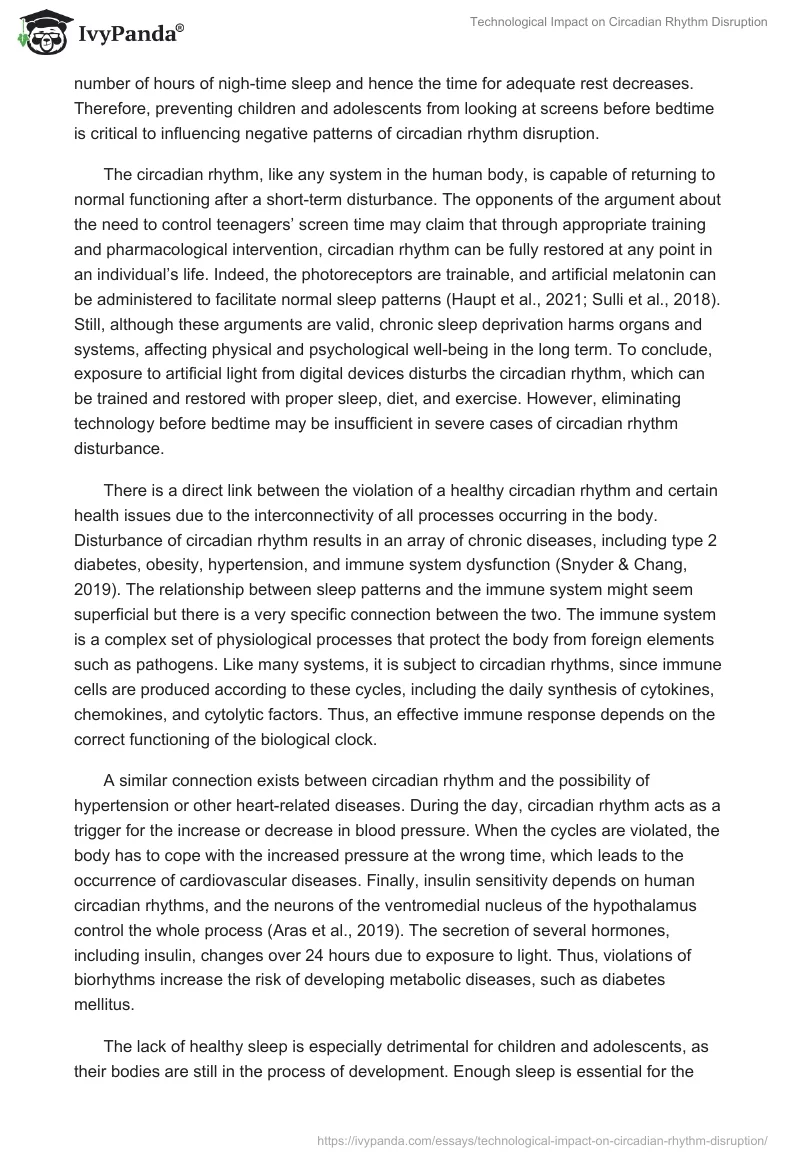Introduction
Sleep is a vital element of the circadian rhythm – a 24-hour biological mechanism that plays a major role in maintaining homeostasis in the human body. The circadian rhythm is regulated by internal mechanisms in the brain and external stimuli (Wahl et al., 2019). In regards to the latter factor, light is known to be a potent influence on the rhythmicity of this phenomenon.
The photoreceptors, known as retinal ganglion cells, convert light to nerve impulses and send them to the suprachiasmatic nuclei (Wahl et al., 2019). The latter, located in the anterior hypothalamus, plays a significant role in regulating the sleep-wake cycles (Snyder & Chang, 2019). These mechanisms were developed in the process of human evolution to help the body and mind rest and restore.
During sleep, the cerebrospinal fluid that circulates between the brain and the spinal cord is cleared of accumulated toxins and cellular debris (Snyder & Chang, 2019). Furthermore, 8-10 hours of sleep is required for children and adolescents for normal growth and development since many essential hormones are released during sleep (Snyder & Chang, 2019). However, the advancement of technologies resulted in excessive exposure to artificial lights at night, which affects the circadian rhythm negatively.
Discussion
Along with the multiple benefits the advancement of technologies brought, it resulted in a significant rise in sleep-related problems since people often use their digital devices before bed. Most adolescents nowadays own or at least have constant access to smartphones, tablets, laptops, and electronic readers that emit blue light (Snyder & Chang, 2019). Exposure to any light inhibits the production of melatonin, a hormone released by the pineal gland which is necessary for increasing sleep propensity, shifting the time when sleep is initiated (Wahl et al., 2019).
Notably, blue light, belonging to the short-wavelength spectrum of 446-477 nm, was found to have the greatest suppressive effect on the release of melatonin (Wahl et al., 2019). Such disruption reduces the number of hours of nigh-time sleep and hence the time for adequate rest decreases. Therefore, preventing children and adolescents from looking at screens before bedtime is critical to influencing negative patterns of circadian rhythm disruption.
The circadian rhythm, like any system in the human body, is capable of returning to normal functioning after a short-term disturbance. The opponents of the argument about the need to control teenagers’ screen time may claim that through appropriate training and pharmacological intervention, circadian rhythm can be fully restored at any point in an individual’s life. Indeed, the photoreceptors are trainable, and artificial melatonin can be administered to facilitate normal sleep patterns (Haupt et al., 2021; Sulli et al., 2018).
Still, although these arguments are valid, chronic sleep deprivation harms organs and systems, affecting physical and psychological well-being in the long term. To conclude, exposure to artificial light from digital devices disturbs the circadian rhythm, which can be trained and restored with proper sleep, diet, and exercise. However, eliminating technology before bedtime may be insufficient in severe cases of circadian rhythm disturbance.
There is a direct link between the violation of a healthy circadian rhythm and certain health issues due to the interconnectivity of all processes occurring in the body. Disturbance of circadian rhythm results in an array of chronic diseases, including type 2 diabetes, obesity, hypertension, and immune system dysfunction (Snyder & Chang, 2019).
The relationship between sleep patterns and the immune system might seem superficial but there is a very specific connection between the two. The immune system is a complex set of physiological processes that protect the body from foreign elements such as pathogens. Like many systems, it is subject to circadian rhythms, since immune cells are produced according to these cycles, including the daily synthesis of cytokines, chemokines, and cytolytic factors. Thus, an effective immune response depends on the correct functioning of the biological clock.
A similar connection exists between circadian rhythm and the possibility of hypertension or other heart-related diseases. During the day, circadian rhythm acts as a trigger for the increase or decrease in blood pressure. When the cycles are violated, the body has to cope with the increased pressure at the wrong time, which leads to the occurrence of cardiovascular diseases.
Finally, insulin sensitivity depends on human circadian rhythms, and the neurons of the ventromedial nucleus of the hypothalamus control the whole process (Aras et al., 2019). The secretion of several hormones, including insulin, changes over 24 hours due to exposure to light. Thus, violations of biorhythms increase the risk of developing metabolic diseases, such as diabetes mellitus.
The lack of healthy sleep is especially detrimental for children and adolescents, as their bodies are still in the process of development. Enough sleep is essential for the normal growth of children and adolescents; hence, the shift in the sleep-wake cycle may interfere with this process (Snyder & Chang, 2019). The deviation of circadian rhythm and thus, sleep from the physiological norm in children leads to a decrease in the amount of communication between brain neurons in the frontal and temporal lobes of the brain. This can result in a delay in speech development and the occurrence of psychoemotional intelligence disorders.
Moreover, in case of a chronic lack of sleep, difficulties in solving tasks for logic and spatial orientation might arise. Therefore, it is of extreme importance to reinforce healthy sleep schedules in children and adolescents, as well as make sure they are not exposed to artificial light before and during their bedtime.
Another significant consequence of sleep deprivation is its negative effect on memory and cognition. Sleep is essential for memory formation, and its insufficiency may affect individuals’ cognitive performance since the lack of sleep harms learning, concentration, and memorization (Snyder & Chang, 2019). The two most widely studied cognitive domains in sleep deprivation research are attention and working memory, which are, in their essence, interrelated. The executive processes of working memory play a role in certain attentional functions, such as sustained attention or vigilance. Both attention and working memory are linked to the functioning of the frontal lobes. Since the frontal regions of the brain are the most vulnerable to sleep deprivation, it can be concluded that such functions as attention and memory are impaired by the violation of circadian rhythm.
When discussing the issue of circadian rhythms and how artificial light from digital devices affects them, it is important to also present arguments that claim that changes in the sleep-wakefulness cycle can be reversed. Certain studies state that circadian rhythm may be trained at any point in life; hence, the abnormal processes can be reversed (Haupt et al., 2021). This stance operates on the assumption that biological regulatory mechanisms are not rigid – in fact, they can adjust to external and internal stimuli to continue functioning and supporting the organism.
An individual can change their sleep schedule into a healthier pattern and reduce the amount of artificial light before bedtime. With time and focused effort, their circadian rhythm would return to normal. However, there is no guarantee that all negative effects accumulated due to improper sleep cycles would also be reversed by the shifts in the biorhythms.
Medication is another way to treat violations in circadian rhythms – for example, artificial melatonin can help induce normal sleep. Other means may include taking sleeping pills or drugs with sedative effects such as antihistamines. Responsible use of sleep medication can help restore normal circadian rhythm more efficiently so that abnormalities can be reverted at any time (Sulli et al., 2018).
Such measures can be especially helpful in cases when the violations in the sleep schedule are caused by insomnia or anxiety. Restoring physiological sleep is the main purpose of sleeping pills; thus, they are able not only to normalize the individual’s sleep but also to improve their general condition through the facilitation of a healthier circadian rhythm.
Finally, reducing exposure to artificial light can also be an effective way to re-developing a normal circadian rhythm. Artificial lighting interferes with the production of melatonin: the green and blue colors of the spectrum provide the strongest influence. Blue light is emitted by some LED and halogen energy-saving lamps, TV screens, smartphones, computers, and smartwatches – this is why it is necessary to limit exposure to them before bed. Thus, since melatonin production depends on light exposure, training the brain by switching off the devices at a specific time may reverse circadian rhythm disruption (Sulli et al., 2018).
This measure should be specifically implemented by parents, as children and adolescents should have limited access to digital devices, especially at night. Children are more sensitive to light than adults: melatonin levels in children are halved compared to adults (Fry, 2022). Restricting access to artificial lights 1-2 hours before bedtime and offering other relaxation means such as light stretching, yoga, or meditation can help develop healthier bedtime habits and facilitate sleep schedule restoration.
Conclusion
Deviations in any processes occurring in the human body lead to health issues – and violations of circadian rhythm are not an exception. Advancements in the technology brought the society new means to make life easier but at the same time, modern digital devices can pose a significant danger to human health. Exposure to artificial light from the screens of TVs, laptops, smartphones, and other gadgets affects natural sleep patterns in the human body and causes a serious disturbance of circadian rhythms. This is an especially actual issue among children and adolescents as they tend to spend hours in front of the screens, consuming and generating content, often without regard to their sleep schedules.
Indeed, healthy sleep patterns can be restored through training, the use of certain medications, and, most importantly, limiting the amount of time a person spends exposed to blue light before bedtime. However, these measures can reverse acquired health consequences only in case of short-term circadian rhythm disturbance.
With long-term sleep deprivation, a person becomes more susceptible to developing severe diseases such as diabetes mellitus, hypertension, or memory issues. Moreover, in children and adolescents, lack of proper sleep might result in fundamental developmental delays, especially regarding brain growth. Thus, it is extremely important to limit their exposure to artificial light and facilitate healthy sleep habits to avoid detrimental health effects in the future.
References
Aras, E., Ramadori, G., Kinouchi, K., Liu, Y., Ioris, R. M., Brenachot, X., Ljubicic, S., Veyrat-Durebex, C., Mannucci, S., Galié, M., Baldi, P., Sassone-Corsi, P., & Coppari, R. (2019). Light entrains diurnal changes in insulin sensitivity of skeletal muscle via ventromedial hypothalamic neurons. Cell reports, 27(8), 2385–2398.e3.
Fry, A. (2022). How does blue light affect children’s sleep? Sleep Foundation. Web.
Haupt, S., Eckstein, M. L., Wolf, A., Zimmer, R. T., Wachsmuth, N. B., & Moser, O. (2021). Eat, train, sleep, retreat? Hormonal interactions of intermittent fasting, exercise, and circadian rhythm. Biomolecules, 11(4), 1-19.
Snyder, C. K., & Chang, A. M. (2019). Mobile technology, sleep, and circadian disruption. In M.A. Grandner (Ed.), Sleep and health, 159-170. Academic Press.
Sulli, G., Manoogian, E. N., Taub, P. R., & Panda, S. (2018). Training the circadian clock, clocking the drugs, and drugging the clock to prevent, manage, and treat chronic diseases. Trends in Pharmacological Sciences, 39(9), 812-827.
Wahl, S., Engelhardt, M., Schaupp, P., Lappe, C., & Ivanov, I. V. (2019). The inner clock—Blue light sets the human rhythm. Journal of Biophotonics, 12(12), 1-14.


